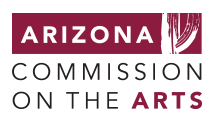In early 2016, the Arizona Commission on the Arts will present workshops on ADA compliance for nonprofit arts organizations. With sessions are designed for both those who are just getting started and those who are ready to move beyond mere compliance, all nonprofit arts organizations are encouraged to participate. To lead these workshops, we recruited Executive Director of VSA Arizona and ADA policy expert Eileen Bagnall. Recently, we spoke with Bagnall about what ADA compliance means for nonprofit arts organizations of all types and sizes.
Does ADA compliance mean something different for small organizations than it does for larger or more established organizations?
Any organization that receives federal funding through the National Endowment for the Arts, the Arizona Commission on the Arts or a local arts agency is required to be compliant with the ADA Regulations. Organizations must comply with any regulation in the ADA that is “readily achievable” for their organization. So, for a smaller theatre or museum, their first steps may be to make sure that their building is physically accessible and then plan out what they’d like to do in the next five years. A larger organization may be able to take on a bigger initiative such as captioning all video in their museum or expanding their services to offer audio description and/or ASL interpretation for tours and performances.
What would you say is the biggest misconception about ADA compliance?
There’s a big misconception that organizations are grandfathered under the ADA Regulations and don’t need to be compliant if their facility is older. Compliance isn’t optional, but it will look different in each organization. Also, any time there are architectural changes in your facility they must be done in accordance with the current standards.
For an organization that is approaching the matter of ADA compliance for the first time, and might feel a little intimidated or unsure where to start, what advice would you offer?
The first step is to create an ADA Plan for your organization. Start with assessing what you have by using one of the resources on the National Endowment for the Arts accessibility page. Prioritize your plan by what you already have, what can be easily implemented and what are the future steps. Include a timeline for this plan along with who is responsible for completing the item and an estimate of the cost. Update this plan annually to keep your ADA Plan on track. VSA Arizona’s ARTability program has resources to help you with your plan, such as our upcoming trainings in Sedona and Tubac. We can also meet with your staff to help create your plan.
For an organization that has already achieved compliance, what’s left to be explored in the arena of accessibility?
There is always something more an organization can do to expand or improve their ADA compliance. With changing technology there are often new and affordable ways to expand your organization’s ADA compliance. Create a Social Story to help guide a patron through the experience when they plan their visit to your museum or theatre. Survey your patrons every three to five years to find out what services they are using and if there are any services they would like to have offered at their facility. Institute annual staff and volunteer trainings to keep everyone up to date on the regulations. Through our ARTability program we offer these types of trainings and can tailor them to your needs.
For more information about VSA Arizona visit www.vsaaz.org, call 602-757-8118 or 520-631-6253m or email [email protected].
Donations to VSA Arizona can be made through their website at www.vsaaz.org.
Questions? Contact Kristen Pierce, Organizational Services Coordinator, at [email protected].



